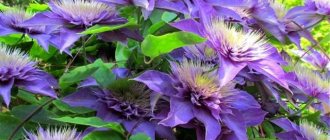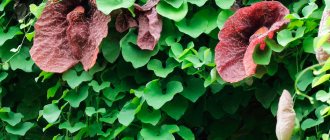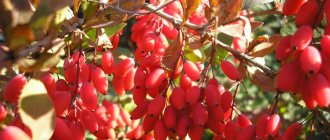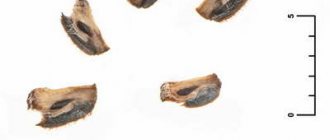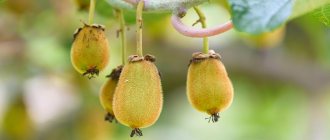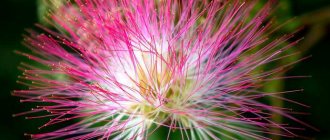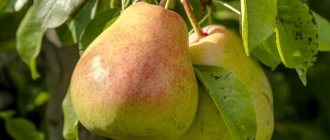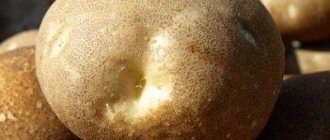Kiwi (Chinese actinidia) is very popular all over the world. It is eaten fresh, added to salads, made into jellies, cocktails, smoothies, jam, and used as a filling for baked goods. The first description of the plant is found in chronicles of the 12th century under the name “Chinese gooseberry”. Today, kiwi is widely cultivated in subtropical countries, but through the selection process, varieties have been obtained that can withstand frost. Therefore, growing “Chinese gooseberries” at home - on a summer cottage or in a city apartment - is quite possible in areas with a temperate continental climate.
Beneficial and harmful properties of kiwi
Kiwi is the berry of a tree-like deciduous vine (Actinidia sinensis), native to Southeast Asia. The sweet-tasting fruits are covered with a thin, fleecy peel, and inside there is tender pulp with small seeds. Thanks to its green color and slight sourness, many people call kiwi “Chinese gooseberry”.
Calorie content of 100 g of kiwi – 61 kcal. The composition of the berries includes:
- fats – 0.52 g;
- proteins – 1.14 g;
- carbohydrates – 14.66 g;
- water – 83.07 g.
I present in the table the vitamins and minerals contained in kiwi:
| Vitamins | Content | Share of daily value per 100 g | Minerals | Content | Share of daily value per 100 g |
| A | 4 mcg | 0,4% | Calcium | 34.0 mg | 3,4% |
| Beta carotene | 52 mcg | 1% | Iron | 0.3 mg | 3,1% |
| E | 1.5 mg | 10% | Magnesium | 17,0 | 4,3% |
| TO | 40.3 mcg | 33,6% | Phosphorus | 34.0 mg | 4,9% |
| WITH | 92.7 mg | 103, 0% | Potassium | 312 mg | 6,6% |
| AT 3 | 0.3 mg | 2,1% | Sodium | 3.0 mg | 0,2% |
| AT 4 | 7.8 mg | 1,6% | Zinc | 0.1 mg | 1,3% |
| AT 5 | 0.2 mg | 3,7% | Copper | 0.1 mg | 14,4% |
| AT 6 | 0.1 mg | 4,8% | Manganese | 0.1 mg | 4,3% |
| AT 9 | 25 mcg | 6,3% | Selenium | 0.2 mg | 0,4% |
Thanks to its rich content of vitamins and minerals, kiwi has a number of beneficial properties for the body:
- improves the digestive process;
- strengthens the body's defenses;
- reduces blood cholesterol levels;
- has an antioxidant effect;
- brings blood pressure back to normal;
- prevents the development of retinal dystrophy;
- normalizes metabolism;
- reduces the risk of developing osteoporosis;
- has antibacterial properties;
- fights free radicals;
- increases hemoglobin levels;
- prevents the formation of stones in the urinary system;
- restores water-salt balance;
- normalizes the activity of the central nervous system.
Have you found out what beneficial properties Chinese gooseberries have? In another article, I told you how to plant strawberries at home. Read it in case you want to grow healthy berries.
In some cases, eating the fruit can cause harm. Fruits are not recommended for the following problems:
- gastritis with high acidity;
- pathology of blood clotting;
- allergic reaction.
In addition to eating, kiwis are popular in the preparation of facial skin care products: masks fight acne, remove dark circles under the eyes, and prevent early skin aging.
Nutritionists recommend drinking kiwi juice
About culture
This tree-like deciduous vine with oval, pubescent leaves is a member of the Actinidia family. Its height is up to 10 m, small white flowers that appear in May are collected in racemes. Kiwi fruits - egg-shaped berries weighing from 100 to 300 g with a thin skin covered with delicate dark fluff - have a pleasant sweet and sour taste and an exotic, pineapple-like aroma. Inside the pulp there are numerous, very small black seeds.
Related article:
Beautiful trees to plant in your garden
Kiwi has ideal qualities as a dietary product. Low calorie content, the ability to stimulate fat burning, high content of vitamins, micro- and macroelements makes this berry useful for many diseases: obesity, angina pectoris, hypertension, iodine deficiency, its consumption reduces the risk of developing trobbophlebitis and cancer.
By studying the DNA of plants, scientists found that Actinidia have common ancestors with coffee and grapes, but two tens of millions of years ago, kiwi had a doubling of its genome associated with the synthesis of ascorbic acid, as a result of which actinidia fruits contain several times more vitamin C than in grapes.
Kiwi varieties suitable for growing on a windowsill
Chinese gooseberry is a dioecious plant, so it will require a female and a male specimen for pollination. To determine the sex of the crop, I advise you to grow 2-4 bushes. Only after 3-4 years, when flowering, you will be able to choose male plants with stamens and female plants with pistils and stamens.
I have kiwi growing beautifully at home on the windowsill, I bought the seeds, ordered them on the Internet, chose the Monty variety, there were 20 pieces in a bag. I present a table of popular kiwi varieties:
| Name | a brief description of | Fruit characteristics | Note |
| Hayward | A liana 2-3 m long with large rounded leaves. | The berries are oval-shaped, flattened on the sides, weighing 100-150 g, sweet and sour pulp with a pineapple aroma. | Requires a pollinator variety. |
| Abott | Fast growing liana. | The berries weigh up to 70 g and are shaped like a pear. | Requires a pollinator variety. |
| Monty | The vigorous species requires constant pruning. | Oval berries weighing up to 30 g. | Does not require a pollinator variety. |
| Bruno | A liana of moderate growth with oblong and pointed leaves. | Oval berries up to 70 g, juicy yellow-green pulp. | Requires a pollinator variety. |
Author's note
Natalia Papanova
Blog author
Male plants of the Matua and Tomuri varieties are used as pollinators.
Have you found out the varieties of kiwi to grow at home? In another article, I told you how to plant nectarines with seeds. Read about which varieties you can grow at home.
Landing technology
The technology for growing kiwi is separately developed for crops that are planted indoors and those intended for open ground. If you make mistakes at the stage of obtaining sprouts from seeds, then even if the plants do not die, they will not differ in quality and, therefore, good yield indicators.
At home
At home, you can grow kiwi from seeds on your windowsill by planting them in a pot with suitable soil. To get seeds, you need to take a ripe fruit and scrape out some of the pulp from it. This mass must be washed to separate the seeds from the pulp. Next, they are placed on a damp cotton pad and, covered with a bag to create a greenhouse effect, placed in a warm place. It is important to constantly monitor the humidity, because if the planting material dries out, it will not germinate and everything will have to start again. When the seedlings appear, the seeds are planted in soil, which consists of 1 part nutritious garden soil, 1 part universal-purpose seedling soil and 1 part sand. There is no need to deeply bury the seeds; you can even just leave them on the surface of moist soil. The dishes with them are covered with polyethylene to create greenhouse conditions.
When the seeds have sprouted, you can plant them
As soon as the shoots appear, the polyethylene is removed, since excessive humidity is dangerous for young shoots. It can lead to their death due to soaking. It is important to constantly ensure that the soil does not dry out, but is not too wet. The length of daylight hours for kiwi seedlings is of great importance and should be at least 18 hours. For additional illumination, it is best to use special phytolamps, which provide optimal light rays for plants, stimulating growth and preventing the occurrence of diseases.
Seedlings should be picked after the appearance of 2 true leaves. This process for kiwi is the same as for any seedlings. Only strong and strong shoots are selected, and weak ones are discarded. When planting, you should try not to injure the roots, as they are particularly delicate and cannot recover if damaged.
Expert opinion
Stanislav Pavlovich
Gardener with 17 years of experience and our expert
Ask a Question
Important! A little compost should be mixed into the soil in the pots in which the plants are planted as fertilizer.
Small sprouts cannot be planted immediately into large containers; their volume should be increased as the vine grows. If there is too much empty unused space in the pot, the soil will begin to sour and bloom, which will ultimately lead to the death of the kiwi.
See also: Planting and caring for persimmons at home and in the open ground
When 5–6 leaves appear, you can replant them in open ground.
After planting, the plants are fed once every 14 days throughout the entire growing season, from March to September. The required duration of daylight hours is ensured by using phytolamps even in summer. If desired, in warm weather you can take kiwis out of the house and into the street. They need to be sprayed every day in the summer heat.
Like any vine, kiwi needs support. It is needed not only for large plants grown in open ground, but also for those growing on the windowsill. For greater decorativeness, it is better to choose an arch support.
In the open ground
It is possible to grow kiwi in open ground from seed only if a cold-resistant variety is selected. First, you need to get kiwi seedlings, and plant the already grown seedlings in the ground. Seedlings are grown in the same way as is done to obtain vines that will be indoors. The only exception is that a week before it is planted in a permanent place, the seedlings begin to be hardened off. To do this, first take the kiwi outside for 30 minutes and gradually increase the time spent outdoors to 6-8 hours. Also, if the seedlings are not tall, you don’t need to organize supports for them until they are planted in a permanent place.
Expert opinion
Stanislav Pavlovich
Gardener with 17 years of experience and our expert
Ask a Question
Important! You should not try to form a tree from a young vine, as this is contrary to the nature of the plant and will negatively affect it.
Seedlings should be planted in a place where the plants will be protected from the wind. It is optimal to find a site for kiwi near the southern wall of the house, but only so that water flowing from the roof does not fall on the plant. Up to 5 female vines are planted per male vine. If there are more of them, then it will not be possible to obtain high-quality pollination and this will negatively affect the crop yield.
The root system of the plant is superficial, so it does not require a deep hole. For large seedlings, it will be enough to dig a hole 50 cm deep. Its width should be the same. Drained, nutritious soils are optimal for the crop. Because of this, before planting the seedlings, broken brick is poured into the hole for drainage, and humus is placed on top.
When planting a plant, it is important to ensure that its root collar is not buried. It should be at a height of 3 cm above the soil level. If you fill it up, the plant will die.
Since the vine is strong and has a high growth rate, it is necessary to organize a strong trellis for it as soon as it is planted in a permanent place. For this purpose, you can use a mesh stretched between the posts, wire between the supports or ropes. You can also arrange wooden supports, as for climbing ornamental crops. Since in regions with a particularly cold climate the vine will need to be covered for the winter by bending it to the ground, you should make sure that the support can be easily freed from the lashes.
Features of cultivation in different regions of Russia
Kiwi can be grown in a garden or greenhouse in different regions of Russia. The ability of a number of varieties to tolerate cold down to -20 degrees without shelter, and up to -30 degrees under cover, allows planting the plant not only in the Krasnodar region with its mild, warm climate, but also in central Russia, as well as some regions of the Urals and Siberia .
Covering with straw for the winter
In warm climates, kiwi is planted in open ground and grown on a strong trellis, from which it is not removed for the winter. At the same time, fruit collection continues until mid-autumn. Flowering in the south of the liana begins early, and the yield is much higher. At the same time, due to the intense summer heat, it will be necessary to constantly monitor the soil moisture, since the vine cannot tolerate drying out. Sometimes they even spray the crop in the evening so that its leaves do not suffer from drying out.
In regions with a temperate climate, such as Central Russia, kiwi can also be grown in open ground. However, this is only feasible if a special greenhouse box is made for wintering the crop, which will protect the plant from the cold without removing it from its supports. This will allow less trauma to the vine, for which disruption of its position is stressful, and at the same time protect it from freezing. To do this, the plant is planted near the wall of the house, to which a covering box is subsequently mounted. This planting option allows you not only to get healthy fruits, but also to decorate your home, as kiwi will create a beautiful green wall.
In the northern regions, where there are severe frosts in winter and cold weather begins early, you can grow kiwi in the country if you wish, but for this it is best to use a greenhouse. In it, the plant will have time to produce maximum yield, since the fruits will ripen even when the temperature begins to drop. In winter, in addition, to preserve the kiwi, it will be necessary to provide shelter for the vine and remove it from its support. Then, under greenhouse conditions and with additional protection from the cold, the vine will not die and will be able to produce a good harvest next season.
How to grow kiwi from a seed in a pot
My dears, now let’s move on to the question of how to plant kiwi at home. First of all, you need to prepare the soil and seeds for planting and select a container. Then sow the seeds and plant the grown sprouts in separate pots.
Preparing for landing
You can order seeds online or buy kiwi fruit in the store. When choosing, take the berry in your hands and inspect it carefully: it should be without signs of rot or damage. Even slightly soft, but not spoiled, will do. You will also need a substrate with a neutral or slightly acidic reaction (pH 5.5-7). You can buy a special soil mixture for citrus crops at a flower shop or prepare the soil yourself.
Priming
Kiwi prefers light, loose and nutritious soil. To prepare soil for seeds, mix equal parts of turf soil, peat, sand and humus. To improve aeration, add a little perlite. To disinfect the soil, pour a strong solution of manganese (5 g per 100 ml) and heat the soil mixture in the oven at +110 degrees for an hour. This procedure will rid the composition of harmful microorganisms and larvae.
Have you figured out how to prepare the substrate for kiwi? Now see how to grow dill at home so that you always have fresh herbs on your windowsill!
Pot
The root system of vines is shallow, but growing in breadth. Therefore, for sowing seeds, prepare low (8-10 cm) but wide plastic pots or rectangular flower containers. Also a great option are seating trays or cassettes. Disinfect the container with a 1% solution of potassium permanganate. Be sure to make drainage holes.
Kiwi leaves are large, so the pot should be low but wide
Preparing seeds for planting
To select kiwi seeds, cut the fruit in half and carefully remove the seeds with tweezers without damaging the protective shell. Then wrap the planting material in gauze and rinse several times under running water. Place the kiwi seeds on a saucer to dry.
Germinated seeds sprout quickly. To germinate kiwi in an apartment, there are two ways, choose either one.
Germinating seeds on cotton wool
- Place cotton wool on a plate, moisten it with warm water and arrange the kiwi seeds.
- Cover the plate with a transparent plastic bag and place in a bright and warm place (temperature +25-28 degrees).
- Remove the bag daily and check the condition of the seeds and the moisture content of the cotton wool, moisten with warm water if necessary.
- When the first roots appear, after about 7-10 days, sow them in the ground.
Germinating seeds on hydrogel
- Dilute a small amount of dry hydrogel powder with water until the crystals swell.
- Then place in a plastic container, place the seeds on top, and cover with plastic.
- When the seeds sprout, you can plant them in the soil along with the remaining hydrogel on the roots.
The first shoots of kiwi seedlings have appeared
Features of sowing
Place a drainage layer of expanded clay (2 cm) on the bottom of the planting container and add the prepared substrate (5-6 cm). Kiwi seeds are very small and may not break through from under a large volume of soil. Therefore, distribute the planting material evenly on the soil and sprinkle with a thin layer of earth, about 0.5 cm. Then moisten it with a spray bottle, cover the container with polyethylene and place it in a warm place (+26-30 degrees). When the first shoots appear (3-6 days), remove the cover and move the seedlings closer to the light, on a southern windowsill. Be sure to protect from direct sunlight with a curtain or gauze. If the seeds have sprouted densely, thin out the crops, leaving the tallest and most powerful sprouts.
Have you read the rules for sowing kiwi seeds? Then quickly see how to plant a pineapple in an apartment. You will only need to buy one fruit to plant.
Watch a useful video about kiwi sprouts:
Picking seedlings
When the seedlings reach a height of 10 cm, it’s time to plant the seedlings, transplant the plants into individual containers with a diameter of 7-8 cm. Water the soil in the planting container with the seedlings generously and leave for half an hour so that the soil is saturated with moisture. Then place a drainage layer on the bottom of the pot, add the prepared substrate, leaving 8-10 cm to the edge. For picking, use the following soil mixture: 2 parts turf soil, ½ part peat, 1 part sand and 1 part humus. The plant has a shallow root system, so carefully remove each seedling and transplant it into prepared holes. Sprinkle soil on top and lightly press with your hands.
Other important nuances of caring for vines
Those who are going to grow kiwi should first of all remember that this is a southern subtropical plant. This is what you need to focus on when creating an optimal microclimate for it. In unsuitable conditions, the vine will most likely simply refuse to bear fruit.
Creating a suitable microclimate
The most important requirement of a vine is sufficient lighting. The pot is placed on a windowsill facing south or southwest. In winter, there will not be enough natural light, so you will have to use fluorescent or special phytolamps, extending the daylight hours to 12–14 hours. It is better to place them so that the light falls on the plant in a horizontal plane.
Kiwi vitally needs a lot of light, and taking this into account, they select a place for the pot
At the same time, kiwi must be protected from direct sunlight during the hottest hours. They cause serious burns, especially if the vine was watered shortly before. You can shade the kiwi with tulle, a paper screen, or several layers of gauze.
With a lack of light, the stems of the vine become unsightly, the leaves turn pale and smaller, and the spaces between them increase. Flowering and, especially, fruiting in such conditions can not be expected.
Kiwi will most likely react negatively to any changes in living conditions. The plant especially does not like sudden temperature changes and cold drafts. Therefore, a place for it is chosen once and for all, approaching this procedure with all responsibility.
Plant care
Caring for kiwi at home is easy. Basically it comes down to regular watering and fertilizing. This is quite enough for the vine to feel good and bear fruit.
Kiwi prefers natural organic fertilizers. It is best to alternate it with mineral fertilizers. The liana spends quite a lot of energy on the growth and formation of fruits, so fertilizing is applied every 12–15 days, starting from mid-March and until October.
Vermicompost is an absolutely natural fertilizer
The very first fertilizing is vermicompost, humus or rotted compost (a source of nitrogen). A circular groove is made in the pot around the plant and fertilizer is added there. During the season, nutrients will gradually flow to the roots along with water. Then you can alternately use complex mineral fertilizer and infusions of nettle leaves, dandelion, wood ash, and bird droppings.
Kiwi needs frequent and abundant watering, but it does not tolerate stagnation of moisture in the pot. To avoid this, 30–40 minutes after the procedure you will definitely need to drain the excess liquid from the pan. Watering is carried out at least once every 3-4 days. At the same time, moisten the earthen ball as evenly as possible. It is best to use a watering can with a divider attachment for this.
A watering can with a divider helps to evenly wet the earthen ball in a pot of kiwi
In extreme heat, in addition to watering, it is advisable to spray the vine with a fine spray bottle. In both cases, water is used heated to room temperature. You can also use a special humidifier. Or simply place basins with cool water next to the kiwi, organize a “company” for the vine from other indoor plants, place wet expanded clay and sphagnum moss in the tray of the pot.
Sphagnum moss retains moisture well, which is very useful for indoor plants in the heat
In winter, the liana sheds its leaves; this is a natural process for it. As soon as this happens, fertilizing is stopped completely, and the number of waterings is reduced to once every 10–12 days. During hibernation, it is advisable to move the plant to a cool, bright room where the temperature is maintained at 12–16ºС.
Kiwi, like most fruit-bearing tropical plants (lemons, pomegranates, pineapples), sheds its leaves in the winter at home
How to care for your home kiwi
Dear readers, do you know how to grow kiwi at home? Chinese gooseberries are inhabitants of humid subtropical forests, so it is necessary to create similar conditions in the apartment. This applies to lighting, high air humidity and abundant soil moisture.
Do you grow kiwi at home?
Not really
Location and lighting
An indispensable condition for the full development of the vine is bright lighting.
Therefore, place the pot on a south or southeast windowsill. With a lack of sunlight, the leaves turn pale and become smaller; if there is too much sunlight, they become covered with brown spots. To create the effect of diffused light, hang a tulle curtain on the window. The best protection is blinds; they prevent the air from heating up on hot summer days and protect leaves from burns. Under natural conditions, the vine reaches towards the sun; on the windowsill, the lighting is only on one side of the pot. Therefore, turn the flowerpot with the plant 2-3 times a week 20 degrees clockwise.
Did you find out how to place a kiwi pot at home? In another article I told you how to store watermelons. Read, for red berries it is also important to choose a place!
A place on the windowsill is the best option for kiwi
Humidity and watering
A resident of the subtropics prefers high air humidity (70-80%).
For this purpose, use a special humidifier or place a container of water nearby. On hot summer days or in winter, when the air in the room is dry, spray the plant with a spray bottle.
To determine the need for watering, tap the side of the pot. If the sound is ringing, the soil is dry; if the sound is dull, the soil is wet. Water the plant with settled water at room temperature in spring and summer 2-3 times a week, in winter - 2-3 times a month. After watering, pour excess liquid from the tray. Please note that drying out or waterlogging is harmful to the root system. In the first case, the leaves droop, wither and fall off, in the second, the root system rots. If the soil is allowed to dry out, place the pot in a bowl of water. When the lump is saturated with moisture, the bubbles on the surface of the soil will disappear.
In addition to knowing how to water kiwi, discover the secret of how to plant feijoas at home. Read, the watering rules will come in handy! The subtropical plant is also a water drinker.
Transfer
The first signs for replanting are a slowdown in the growth of the vine and the growth of the root system through the drainage holes. Consequently, the pot is small, the plant requires a container 2 cm higher and wider.
Replant young plants 2-3 times a year, older than 5 years - once every 2-3 years. To replant, water the soil generously, remove the plant with a lump, free the root from the soil and rinse with a 1% solution of potassium permanganate. If you are replanting adult vines, shorten the root by 1.5-2 cm and sprinkle the cuttings with crushed ash. Treat the prepared container with boiling water. Place a drainage layer of expanded clay on the bottom, add a substrate as when picking seedlings. Make a hole in the soil, immerse the root in it, cover it with soil, compact it and water it.
Knowing how to transplant kiwi, you can move on. Master the rules for planting lychees at home and you will grow another exotic fruit.
Watch a useful video: replanting kiwi with cuttings
Author's note
Natalia Papanova
Blog author
Each new pot should be 5-8 cm larger in diameter than the previous one.
Selection and application of fertilizers
For kiwi, the best way to feed is liquid or dry vermicompost. It includes potassium, phosphorus and nitrogen necessary for plant development. Unlike manure or compost, it has no odor. It is better to use a liquid composition (250 ml per 10 liters of water). Apply fertilizer 1-2 times a month in spring and summer.
Before wintering, the plant requires 2 phosphorus-potassium fertilizing: the first - in early September, the second - a month later. For complex fertilizers, use Potassium Monophosphate in the form of powder or granules. It can be purchased at a specialty store. To feed kiwi, dissolve the drug in water according to the instructions, then water and spray the kiwi.
It's not just kiwis that need fertilizer. In another article, I told you how to plant an avocado at home and described the rules for caring for it. The tree is not very demanding when it comes to feeding!
Liquid vermicompost is the best fertilizer for subtropical vines
Trimming
I don’t prune in early spring - the plant loses its juice, becomes exhausted and dries out. You should also not shorten shoots in the summer. This leads to the shedding of dormant buds of the current season. When the plant sheds its leaves (late autumn), remove unnecessary shoots and remove dried fruit-bearing shoots.
Watch a useful video on how to properly prune a young bush.
Kiwi at home
In nature, kiwi (the plant is known to botanists as Actinidia sinensis) is a tree-like vine that prefers a tropical or subtropical climate. At the tops of the shoots, whole clusters of large fruits ripen, similar in appearance to very large gooseberries. Depending on the type, they may be smooth or rough to the touch.
In nature, the kiwi vine reaches 7–10 m in length
In principle, there is nothing difficult in creating a microclimate for kiwi that is close to optimal. But the plant belongs to the category of dioecious. This means that for fruiting to occur there must be at least two specimens - male and female. They can only be distinguished during flowering. The former, acting as pollinators, lack a pistil, but have many stamens. One male plant is enough to pollinate five to six female plants. The only self-pollinating kiwi variety in existence is Jenny. But even in this variety, the presence of male plants nearby has a positive effect on productivity.
The presence of a male plant is useful even if the variety is self-pollinating
Video: how to determine the sex of a kiwi plant
Amateur flower growers value kiwi not only for its fruiting, but also for its long and abundant flowering. Large five- or six-petalled flowers gradually change color from snow-white to yellowish-cream, lemon or lime.
Fruits at home, as a rule, ripen less than the description of a particular kiwi variety promises. But in terms of the content of vitamins, macro- and microelements, and taste, they are in no way inferior to those grown outdoors. Ripe fruits are easily separated from the vine. They are stored in the refrigerator, the approximate “shelf life” is one and a half to two weeks.
“Homemade” kiwis are small but very tasty
There are no problems with obtaining kiwi seeds at home. They can be taken from any berry purchased in the store. But seedlings grown in this way rarely inherit the varietal characteristics of the “parent”, and the taste of the fruit leaves much to be desired. Therefore, they are most often used as a rootstock, and any seedling of a certain variety purchased from a specialized nursery acts as a scion.
Viable seeds can be obtained from the kiwi fruit, which can be purchased at any grocery store.
You will have to wait quite a long time for the harvest from kiwi grown from seeds. As a rule, such plants bloom for the first time no earlier than six years after planting.
It is advisable to obtain planting material from mature and healthy-looking fruits
For proper development of kiwi, warmth and sunlight are vital. Therefore, the pot is placed in the brightest place in the apartment, for example, on a south or south-west window sill, turning it periodically (every 2–2.5 weeks) so that the heat is distributed evenly. Cold drafts are strictly contraindicated. Equally important are regular fertilizing (preferably organic) and proper watering.
In nature, kiwi is a vine, so you need to take care of support for it in advance
For some reason, actinidia juice has an effect on cats (and, to a lesser extent, cats) similar to that of valerian tincture. Therefore, it is worth putting the pot somewhere where cats definitely cannot reach it, or surrounding the plant with a net.
Cats do not eat kiwi leaves and shoots, but they can severely damage the plant when trying to get to the juice, which for some reason they are very partial to.
How to propagate indoor kiwi
Actinidia is propagated into clefts using hardened and green cuttings, using the grafting method. Such methods convey the full varietal properties of the mother plant.
Into the cleft with a hardened cutting
For this method, choose hardened shoots with buds. Cut the lower edge obliquely under the lower bud, leave a distance of 1 cm above the upper one. Then place the cuttings in water for 12 hours, adding the growth stimulator Kornevin. Place a drainage layer of pebbles on the bottom of the seedling container, a prepared soil mixture on top (peat and sand in equal quantities) and plant the cuttings. Then moisten the soil, cover each specimen with a glass jar and place in a warm, dark place.
Remove the cover daily, check the condition, and water the soil if necessary. In about a month, the cuttings will form a root system. Transplant the seedlings into individual pots with a drainage layer and prepared substrate.
Into the cleft with a green cutting
For this method, choose a green shoot with buds (at least 3-4) in summer. Make the lower cut at an angle of 45 degrees, and make the upper cut exactly 1 cm above the top bud. Then place the cutting in a container of water. When roots 3-4 cm long appear, dip them in Kornevin’s solution. After 2 days, plant the seedling in a pot filled with drainage from pebbles and prepared soil mixture.
Propagation of kiwi by green cuttings
Budding
A simple method of grafting is budding in the butt. The procedure can be performed in spring or summer. The main condition is the air temperature above +10 degrees.
Select a rootstock plant and remove all leaves and shoots below the grafting area (40 cm). Cut fresh shoots with buds from the scion. On the rootstock at an angle of 45 degrees, make 2 cuts: one 6-7 mm long, the second 3 mm higher, bring the second down so that it connects with the first. On the scion cutting, do the same procedure, only the bud should be in the center of the shield. Now place a shield with a bud in the cut on the scion and wrap the grafting site with polyethylene.
Having grown exotic fruits at home, now it is important to learn how to properly store kiwis so that they always remain fresh.
Watch useful video tips from a kiwi breeding specialist.
Reproduction methods
Kiwi reproduces quite easily in several ways.
Cuttings
Kiwi can be propagated from cuttings only if they are hardened. To do this, a hard shoot with 3 buds is cut obliquely and, after being kept in the root formation stimulator, it is planted in the same way as any other cutting.
When pruning in summer, you can get green cuttings. They are rooted similarly to lignified ones. However, the possibility of growing new plants from green cuttings is lower.
Seeds
A simple method that requires growing seedlings from seeds obtained from a ripened fruit. If kiwi ripens already removed from the vine, then the quality of the planting material will be quite low. It will also be possible to grow a liana from it, but many of the sprouts will be too weak. If desired, seeds can be purchased at the store.
Dividing the bush
Kiwi can be propagated by division only if the vine has many young shoots. Since the root of the plant is delicate, this method is traumatic and can cause the death of the vine. It should only be used as a last resort.
If you wish, you can try to make layering from the bush by rooting young kiwi shoots without separating them from the parent plant. When roots form on the shoots pressed to the ground, in the spring it will be possible to separate new kiwis from the parent vine without harm to it or themselves.
Graft
You can graft kiwi in spring or summer. For this purpose, a rootstock is selected, which most often serves as an extra male vine. All shoots and leaves are cut off from it at a distance of 40 cm down from the grafting site and then buds are replanted from another plant. When a shoot is grafted immediately, it is important that it already has fully developed buds. The entire grafting process is no different from what happens with other plants.
The optimal air temperature during the period when vaccination is done is +10 degrees. At this time, metabolic processes in plants are somewhat slower, and the likelihood that a planted bud or shoot will be rejected is reduced to a minimum.
Expert opinion
Stanislav Pavlovich
Gardener with 17 years of experience and our expert
Ask a Question
Important! The bandage can be removed from the grafting site only after it has completely taken root.
Pests and diseases
The most dangerous pests for indoor actinidia are spider mites, scale insects and whiteflies. Three pests feed on the sap of the plant.
Spider mite
Signs of a mite are thin threads on the leaves and petioles, small white dots on the lower plate of the leaves. At the initial stage, onion infusion will help in the fight against the pest. To prepare, chop the onion and add 1 liter of warm water. After 10 hours, strain through cheesecloth and spray the plant. If the insect infestation is widespread, treat with Inta-Vir or Fitoverm, and also add Temika granules to the soil before watering.
Shchitovka
Signs of scale insects are dark brown seals on the leaves, which gradually turn yellow and dry out. To combat the pest, spray the plant with warm water from a spray bottle. Then wipe the leaves with a cotton swab moistened with an alcohol solution (70%). After 1-1.5 hours, treat with laundry soap foam. Repeat the procedure every other day, then after 3 days. If pests have attacked the entire plant, it must be destroyed.
Whitefly
Whitefly is another unpleasant pest that loves warmth and high humidity. Insects live on the lower leaves, forming a thin sticky film. If you shake the actinidia, the whiteflies will rise into the air. At the initial stage, use a folk remedy - garlic infusion. Pour in 1 tsp. chopped garlic with a liter of water, let stand for a day. Then spray the plant with a spray bottle. In more advanced cases, use the drug Fufanon, Mospilan or Confidor, one treatment is enough.
Don't like mites, scale insects and whiteflies in your apartment? Then find out how to plant persimmons from seeds. The tree is not afraid of pests, and it is not picky in its care!
Root rot
Among the diseases for kiwi, the most dangerous is root rot. The cause of the disease is waterlogging of the soil. Signs are leaf drop and poor plant development. Root rot is difficult to combat. The best way is to replant the plant and replace the soil. Remove the bush from the pot, wash the root system with a 1% solution of potassium permanganate and remove rotten parts. Prepare a new substrate, treat it with a fungicidal solution and replant the plant.
Light cobwebs on the leaves are the result of the action of spider mites
FAQ
Natalia Papanova
Blog author
Ask your question
Beginning amateurs have many questions, I will answer the most interesting ones.
When will kiwi grown from seeds bloom?
Kiwi grown from seeds will bloom for the first time in 4-5 years. White flowers become yellowish over time. On one bush there can be only male ones with stamens or female ones with stamens and pistils.
Do kiwi fruits grown at home differ in taste?
Kiwis from seeds do not inherit maternal qualities. The taste of the fruit will vary.
Why does the plant die?
The plant dies when the soil becomes waterlogged or dries out. Poor lighting, deficiency of minerals in the soil and pests may also be reasons.
Sowing kiwi seeds
Pre-sowing seed preparation
Before sowing, kiwi seeds need to be germinated. It is best to sow in the spring. Purchase a well-ripened fruit with no signs of spoilage or rotting in a store or market, wash it thoroughly and divide it into several slices with a knife. Then remove the pulp with seeds, mash it thoroughly, place it in a deep bowl and fill it with clean water. After a while, when the kiwi pulp becomes limp, carefully separate the seeds from it: the ripened seeds should float on the surface. Place them on a paper napkin, let them dry, then place them on a saucer, cover with moistened gauze, and film on top of the gauze. After about two weeks, tiny white sprouts will appear on the seeds.
In the photo: Kiwi seeds
Rules for sowing kiwi seeds
Take a low pot or container and place a layer of drainage on its bottom - expanded clay is ideal for this. Then fill the container with a pre-disinfected soil mixture - this can be ready-made soil for seedlings or a self-prepared substrate from equal parts of peat and sand. Sprouted kiwi seeds are buried into a moist substrate no more than 0.5 cm.
Be careful that when sowing, the sprouts do not fall off the seeds: a seed without a sprout will not sprout!
- Photo of pink marshmallow
After sowing, the substrate is sprayed with clean water, and the container is covered with film or glass and placed in a warm, bright place. As soon as the first shoots appear, the crops are watered abundantly, the covering is removed, and the weakest shoots are pulled out. After each kiwi has formed a pair of true leaves, the seedlings are picked into small separate pots. Only the strongest and most well-developed seedlings need to be replanted.
In the photo: Kiwi seedlings
Caring for young seedlings
Water the seedlings regularly, but moderately. Remember that for a plant such as kiwi, both overdrying of the substrate and waterlogging, which can cause stagnation of fluid in the roots, are equally harmful. In winter, the substrate is moistened no more than once every two weeks, and during the growing season, watering is carried out on average once every two days. On hot summer days or when heating devices are operating at full power in the room, it is recommended to systematically spray the plants with a sprayer.
Kiwi is light- and heat-loving, so it is best to grow it on a south-facing windowsill. When kept on a western or eastern windowsill, the plant may need additional artificial lighting.
To get a rich harvest of fruits in the future, kiwi seedlings need to be fed with compost in a timely manner. If you keep the plant in suitable conditions and properly care for it, then in the fourth year it can bear fruit.
In the photo: Growing kiwi outdoors
Let me sum it up
I give some tips for growing Chinese gooseberries:
- To prevent the vine from stretching too much upward, pinch the top. This stimulates the growth of side shoots and forms a bush.
- If you get a lot of male seedlings, you can graft the buds of female plants.
- If the leaves become crushed, turn red, dry out and crumble, or are covered with brown spots, feed the plant with vermicompost.
- Remember: kiwi is a dioecious plant. If you want to have fruits in addition to flowering, plant a female and a male specimen in the same container.
- Be sure to check the plant a couple of times a month for fungal manifestations and pests.
At first glance, growing kiwi from seeds is difficult, but it is not so. All it takes is time and desire! The result is beautiful flowering and sweet and sour fruits.
Benefits of growing kiwi
Growing kiwi from seeds at home or on the plot has a number of advantages. This allows you to get fresh, tender berries that have not been subjected to any chemical treatments to increase shelf life, and therefore do not harm the body. In addition, cultivating Chinese delicacy actinidia, as kiwi specialists call it, on your plots will allow you to gain a new and interesting gardening experience.
For lovers of indoor ornamental plants, kiwi is also of interest, since this tree-like vine feels good in a pot and can bear fruit in such conditions. Externally, the plant looks unusual and attractive and, if there is enough space in the house, it can fit well into the interior of the apartment, decorating it with its presence.
How to choose a place to plant actinidia
Actinidia can be planted both in the fall (before the first frost) and in the spring - the latter is preferable.
It is better to purchase seedlings of varietal plants only in reliable places - nurseries or botanical gardens.
The location for actinidia should be chosen carefully. It must be remembered that this plant prefers fertile soil that can allow moisture and air to pass through, but does not like high groundwater levels.
Actinidia feels good near buildings and fences, on their southern side, but it is better to protect a young tree from open sun. With age, it begins to love direct sunlight.
Botanical description
The name of the shrub vine is translated from Greek as a ray; the columns on the ovary are located in a similar way. The genus, of which Actinidia is a representative, unites up to 70 species. In the wild, the tree is found in the Himalayas. Clinging to the branches, the vine rises to a height of almost 15 meters. Thin young shoots with a reddish tint are covered with shiny lentils. Actinidia grows in greenhouses and greenhouses; it looks great as a hedge, but without support it does not reach 2 meters.
The large leaves of the vine look a little like a heart and are distinguished by the fact that they change color at each time of the year. In spring they have a yellowish color, at the beginning of summer they acquire a green tint, during flowering the tips become white, then pink and even crimson. Thanks to this phenomenon, actinidia looks unique. Buds are formed in leaf blades. Some plant species have snow-white corollas, while others have yellow or orange flowers with a delicate aroma.
Actinidia deliciosa grew in China and began to be cultivated in Europe only at the end of the last century. The fruits of such a vine are sold on the market and are known to everyone as kiwi.
In mid-latitudes, a representative of the family is grown in dachas for decorative purposes and used as a flowering hedge. The fruit of frost-resistant varieties of deciduous vines is small in size and densely covered with hairs; not all fruits are eaten.
Popular varieties of female kiwi plants
- Hayward is the most widespread kiwi variety in the world. Late ripening. Vigorous. Productivity is high. The flowers are initially white, and after 2–3 days they become creamy, up to 6.5 cm in diameter, solitary, rarely in inflorescences of 2–3 flowers. Flowering lasts 10–14 days. The fruits are large, smooth, oval in cross section. Fruit length up to 6.5 cm, weight up to 100 g. The pulp is straw-greenish.
- Bruno – early ripening. Vigorous. The flowers are white-cream, 5.5 cm in diameter, either solitary or collected in inflorescences of 2–3 pieces. Flowering lasts 10–12 days. The fruits are cylindrical in longitudinal section and round in cross section. Length up to 8 cm, circumference – 12 cm, weight 50–70 g. The flesh is green.
- Monty – mid-season. Vigorous. The flowers are white-cream, up to 5 cm in diameter, solitary or in inflorescences of 2–3 pieces. Flowering lasts up to 12–14 days. The fruits are medium to large, slightly pear-shaped in longitudinal section and oval in cross section. Their length is 6.4 cm, circumference 13.8 cm, weight about 30 g. The flesh is greenish-yellow. The taste, unlike the listed varieties, is mediocre.
- Abbot is a mid-season kiwi variety. Medium height. The flowers are white-cream, up to 6.5 cm in diameter, both single and collected in inflorescences of 2–3 pieces. Flowering lasts 10–12 days. The fruits are evenly colored, elongated in the longitudinal direction and rounded in the transverse direction. Fruit length 6.6 cm, weight 65 g. The flesh is green.
- Jenny – medium early. Medium height. Self-pollinating. Fruits weigh up to 60–80 g. Similar to Hayward , but have smaller fruits.
Popular varieties of male kiwi plants
- Matua is a profusely and long-flowering variety. Vigorous. Flowers – from single to collected in inflorescences of 3–5 pieces. The villi on the peduncle are single and short.
- Tomuri - blooms somewhat later than the Matua . Vigorous. Flowering is long lasting, but less abundant. The flowers are large, from single to collected in inflorescences of 2–7 pieces. The villi on the peduncle are thin and long.
In the photo: Kiwi fruit grown in open ground in the Moscow region
Find out how to grow figs in open ground in the middle zone.
Diseases and pests of vines. Ways to deal with them
During a long drought, actinidia growing in the garden are attacked by caterpillars and spider mites that feed on the juice of the leaves and gnaw through the skin of the berries. They fight them by spraying trees with insecticides. The liana is affected by powdery mildew and anthracnose. To protect actinidia from diseases, they resort to treatment with fungicides - “Radomil”, “Switch”, “Horus”.
We also have to fight against soil pests in the form of the cockchafer and armyworm, which damage the roots; Aktara solution is poured into the ground. Herbicides such as Roundup are used to kill weeds.
How to distinguish male and female kiwi plants
I planted the first kiwi seedlings in my garden near Moscow about 10 years ago, but they didn’t bloom until 2012, although in the southern regions they bloom in the 3rd–5th year. The male plant bloomed first, and the next year the female plant bloomed at the same time as the male plant. Before flowering, it is difficult to determine the gender of kiwi, but when they bloom, this difference is clearly visible: on female flowers the pistil is much larger.
In the photo: Male kiwi flower
the varietal identity of the female plants (variety Hayward ) only when the plants bloomed and the fruits began to ripen. Not knowing how the local bees and bumblebees would receive the overseas guest, I played it safe a little: I hand-pollinated all the flowers on the female vines with a male flower.
In the photo: Female kiwi flower
The result was not long in coming, and now furry aliens from distant subtropics are ripening in my garden. However, I think that the insects could have managed it without my help. For the viability of pollen and the activity of pollinating insects, it is optimal that during the flowering period, which in our area occurs at the end of May - beginning of June, the air temperature is +15...+20 °C.
